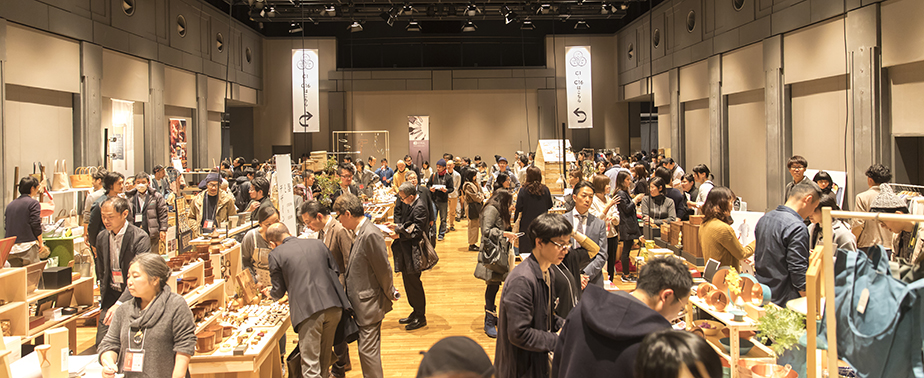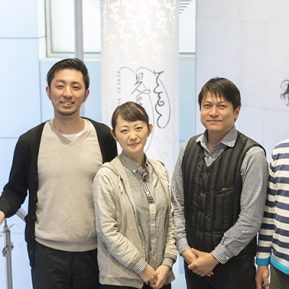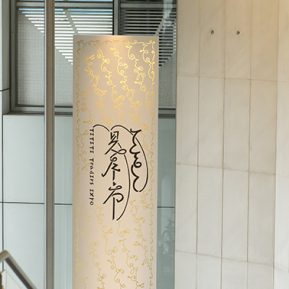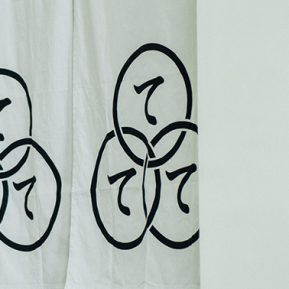– Food and TE TE TE
– Ancient wisdom from medicinal herbs

“Currently, 90% of the medicinal herbal teas available in Japan are imported products. I hope to get the word out about the benefits of the traditional teas passed down in various regions.” (Lyie Nitta, {tabel} CEO and food researcher)
In a tasting of traditional teas made with domestically grown plants raised without pesticides or chemical fertilizers, the domestic herbal tea brand {tabel} earned high praise. CEO Lyie Nitta says, “Many people hear ‘medicinal herbs’ and expect them to be bitter and taste bad. But if you select the ingredients carefully, they taste very good. And they’re good for your health, too. There is a reason knowledge like this has been passed down from generation to generation.”

Packages of ingredients gathered by Nitta in her travels across Japan, including “Ancient Japanese Lotus Leaf Tea from Yatsushiro,” “Fragrant Shell Ginger Tea from Ishigaki Island,” and “Warming Angelica Acutiloba Tea from Takatori, Nara.” Nitta says they preserve the efficacy of the medicinal herbs by doing as much of the processing as possible where the herbs are grown.
“We chose to exhibit at TE TE TE rather than a food-related trade show because the exhibitors and visitors are linked by shared values. The common goal of mindful and sustainable living makes it possible to convey ideas without obstacles, for dishes or accessories or food. This is our third time exhibiting here, and I’ve gotten to know more of the other exhibitors. It’s kind of like an annual reunion. I’ve often asked other exhibitors for advice, and we met our packaging company based on a recommendation from a fellow exhibitor.”
[tabel]
>> http://tab-el.com
– Getting the word out once again about Fukuoka’s nori

In addition to standards such as yaki-nori (toasted seaweed) and aji-nori (flavored seaweed), products such as taki-nori (hand-cut and steamed seaweed) are made possible by the producer’s intimate knowledge of nori’s flavor.
The booth for [Enoura Nori Honpo] from Fukuoka prefecture drew attention at the show with its stacks of cardboard boxes emblazoned with the text “Fukuoka Nori.” As he offered nori for visitors to taste, Shuji Morita talked about the flavor of fresh nori, saying, “I wanted everyone to experience what freshly toasted nori tastes like, so we toasted it right before we left Fukuoka.”

Some of the buyers who tasted the nori commented, “It makes me want rice.”

Shuji Morita (left) was once a seaweed fisherman, but is now involved in production, processing, and distribution due to a desire to provide great nori for people’s tables one more time.
“Many people aren’t aware that the Ariake Sea produces nori, or that the nori has an amazing taste. Many have probably forgotten that nori from different places tastes different. Developing sales channels is important, of course, but our big objective at this show is to get the word out about Fukuoka’s nori.”
[Enoura Nori Honpo]
>> http://enouranori.com
– The background behind craftsmanship
– Construction and crafts
![Making doorknobs, handles, towel hangers, and more to order is one of the strengths of [sen]](http://test-craft.oikaze.biz/wp/wp-content/uploads/2017/03/170316_sp_tetete2_2_07.jpg)
Making doorknobs, handles, towel hangers, and more to order is one of the strengths of [sen]

Left: a lineup of lighting from hanging to standing pieces to match a variety of interior designs. Right: accessories such as brass pins are also part of the lineup.
“We began showing at TE TE TE last year, but this year’s new venue has drawn a wider range of visitors. Many architects, designers, and people in interior design have come by, leading to more detailed discussions about special orders. Many TE TE TE visitors take their time to look around the event hall, so it gives us a chance to really explain our techniques and designs. When you’re involved in making things outside of Tokyo, you don’t get many opportunities to interact with buyers and users in a truly meaningful way.”
[sen]
>> http://www.senkanamono.com/
– The copperware coloring specialists
![The brand name [tone] indicates an expression that changes slowly with everyday use.](http://test-craft.oikaze.biz/wp/wp-content/uploads/2017/03/170316_sp_tetete2_2_11.jpg)
The brand name [tone] indicates an expression that changes slowly with everyday use.

With no two objects completely alike in mottling and coloration, copperware coloring shows the appeal of handicrafts.
Yukitoshi Toda of [Kurasuhito Kurasutokoro], which handles the brand direction and product design for [tone], says, “I’d like to get the word out about the techniques developed in Takaoka and the background behind them. Takaoka’s copperware production is supported by countless specialists. Division of labor and specialization led to craftsmen who focused only on coloring, and the skills to create an infinite spectrum of colors for copper. Many might think of it as metal discoloration or degradation, but I’d like for people to know there are techniques to create these textures in a purposeful way.”
[momentum factory Orii]
>> http://www.mf-orii.co.jp
[Kurasuhito Kurasutokoro]
>> http://www.kurasu-kurasu.com
– Born from TE TE TE
– The meaning of lighting a flame

Candles made from rice bran, presented in a modern package that is easy to pick up and makes a nice gift.
Since its founding in 1914, [Daiyo] in Shiga prefecture has provided candles to Eihei-ji, one of the main temples of Soto Buddhism, and continued the traditions of Japanese candlemaking. Now in their fourth year exhibiting at TE TE TE, they showed traditional haze wax candles, rice candles made from wax extracted from rice bran, picture candles decorated by a painter of Kyoto’s Kiyomizu-yaki ceramics, and more. With the addition of tealight candles from their “hitohito” brand that revisits the relationship between people and flames, the booth showed both the traditions and present of Japanese candles.

Products that add fun and playfulness to the reasons to light a flame in everyday life.
“Unlike in the past, Japanese candles are no longer a necessity for everyday life. Because of that, we want to take this opportunity to spread the word about the history and production of Japanese candles. Business is important, of course, but more than that, both we and the consumers need to get together and think about what it means to light a flame in everyday life. This is our fifth time at TE TE TE. We keep coming back because this isn’t just a place for selling.” (Satoshi Onishi, Daiyo)

Satoshi Onishi, the fourth generation of Daiyo
[Daiyo]
>> http://warousokudaiyo.com
– The yearly schedule of a small-scale workshop

A wide variety of fireworks, ranging from sparklers made from handmade Japanese paper colored with natural dyes to handheld fireworks that create a colorful spectrum of sparks through careful mixes of explosive powder. The firework shaped like Mt. Fuji (center) is “Hana-Fuji,” a new product for 2017.
Tsutsui Tokimasa Toy Fireworks Factory is a Fukuoka prefecture fireworks manufacturer that has been in business for 90 years. This is their third time exhibiting at TE TE TE. As one of only three manufacturers of sparklers remaining in Japan, they pass on traditional techniques as well as come up with new ways to enjoy fireworks. By using only local ingredients such as pine soot from Miyazaki, natural dyes, and handmade Japanese paper from Yame, they work toward a revival of domestic fireworks.

Sparklers made with carefully selected ingredients and refined techniques are popular as gifts and souvenirs.
Kyoko Tsutsui of Tsutsui Tokimasa Toy Fireworks Factory says, “Each year, we target the TE TE TE Traders Expo in February when we plan our new product development schedules. Fireworks are seasonal items with high demand in the summer, so it’s the perfect time to announce products. We work with outside designers for our product development, so TE TE TE is built into everyone’s annual schedules. For small workshops like ours, it’s important to ensure efficiency in the cycle that goes from product development to new product announcement to business discussions to the busy period. Thanks to our exhibits at TE TE TE, our products have reached shelves not only at sundry and interior goods stores but also apparel stores, and the sales channels and consumer base have changed significantly. We hope to stay flexible and adjust as things continue to change.”

Colored explosive powder can be seen through transparent natural cellulose in “Touka” (transparent flower).
[Tsutsui Tokimasa Toy Fireworks Factory]
>> http://tsutsuitokimasa.jp
– TE TE TE regulars

Taiichi Kirimoto, the seventh generation of Wajima Kirimoto.

Wajima Kirimoto is producer and seller of woodcraft and lacquerware in the city of Wajima in Ishikawa prefecture. Unlike many Wajima-nuri lacquerware workshops that specialize in one part of the process, Wajima Kirimoto takes the rare approach of handling everything, from processing the wood to applying the lacquer. With their high level of technical skill and conceptual abilities, they continue to create dishes, accessories, furniture, and more that are oriented toward modern living. In recent years, they have branched out into interior construction using Wajima materials and techniques to break new ground in the use of wood and lacquer. They have participated in every TE TE TE Traders Expo, beginning with the first event.

Wall panels for interior construction materials. Last year, Wajima Kirimoto earned attention in Japan and overseas after creating counters and wall panels for a Japanese restaurant in Singapore.
“Before TE TE TE Traders Expo, there were almost no opportunities for small workshops to really interact with buyers. For a tiny workshop, the chance to exhibit with our own limited funds and talk in depth about even the background behind our work is invaluable,” says Taiichi Kirimoto of Wajima Kirimoto.
“Compared to before, the relationship between handicrafts and design has become much closer. But getting products into distribution still requires a lot of effort. I’d like to see TE TE TE Traders Expo retain the same quality and play a role in changing distribution and sales for handicrafts. I don’t think it really needs to do anything different. The four people on the operations team have a solid philosophy, and that’s why so many exhibitors and attendees recognize the value of what they’ve created.”
[Wajima Kirimoto]
>> http://www.kirimoto.net/
Return to Part One >> TE TE TE Traders Expo 2017 Exhibitor Interviews (Part One)
SPECIAL
TEXT BY YUJI YONEHARA
PHOTOGRAPHS BY MITSUYUKI NAKAJIMA
17.03.16 THU 23:28




